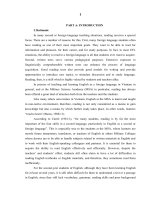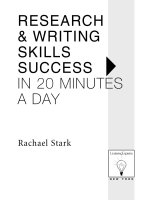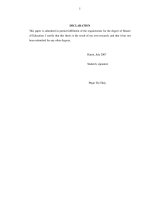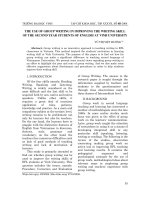Research report: "Writing in teams to improve writing skills for students of English Language at the University of Vinh" doc
Bạn đang xem bản rút gọn của tài liệu. Xem và tải ngay bản đầy đủ của tài liệu tại đây (128.98 KB, 10 trang )
tr−êng §¹i häc Vinh T¹p chÝ khoa häc, tËp XXXVII, sè 4b-2008
35
THE USE OF GROUP WRITING IN IMPROVING THE WRITING SKILL
OF THE SECOND YEAR STUDENTS OF ENGLISH AT VINH UNIVERSITY
VŨ THỊ VIỆT HƯƠNG
(a)
Abstract. Group writing is an innovative approach to teaching writing in EFL
classrooms in Vietnam. This method inspired the students’ motivation in learning
writing skill at Vinh University. The purpose of this paper is to find out how far
group writing can make a significant difference in teaching second language of
Vietnamese Universities. We present some crucial views regarding group writing in
an effort to highlight the pros and cons of group writing. And we also make some
effective suggestions about Stechniques and procedures in order to help students
improve their writing skill.
I. INTRODUCTION
Of the four skills namely: Reading,
Writing, Speaking and Listening,
Writing is widely considered as the
most difficult and the last skill to be
acquired both by non- native and native
speakers. Unlike other skills, it
requires a great deal of conscious
application of rules, patience,
knowledge and practice. As a main and
compulsory subject at the tertiary level,
writing remains to be problematic not
only for learners but also for teachers.
On the one hand, the learners have to
grapple with the distinctive features of
English from Vietnamese in discourse,
rhetoric, style, grammar and
vocabulary; on the other hand the
teachers face numerous difficulties such
as lack of good methods of teaching
writing and lack of motivation of
learners.
This study is primarily intended to
find out whether group writing can be
used to improve the writing skills of
EFL students at Vinh University. This
question includes the issues, namely:
Procedure, Correction and Evaluation
of Group Writing. The answer to the
research paper is sought through the
information supplied by teachers and
students to the questionnaires and
through class observations made in
three classes of Intermediate level.
II. BACKGROUND
Group work in second language
teaching and learning has interested a
number of methodologists since the late
1960s. In some earlier studies much
focus was given to the effect of group
work on the learners' communication.
Later, group work caught the attention
of researchers in using it as a means of
developing integrated skill or any
particular skill (speaking, listening,
writing or reading). The following is the
review of the studies, observation
concerning making group work an
active tool in improving EFL teaching
and learning results. It contains the
pedagogical argument and
psychological rationale for the use of
group work, methodological ideas about
relevant steps in employing group
writing and teachers' experience with
group writing.
NhËn bµi ngµy 4/9/2008. Söa ch÷a xong 27/10/2008.
VŨ THỊ VIỆT HƯƠNG THE USE OF GROUP WRITING IN IMPROVING , TR. 35-44
36
Long and Porter (1985) make a
summary of the pedagogical and
psychological rationales for using group
work in second language acquisition
made by several researchers and
methodologists. They emphasize that
the aim of employing group work is to
provide a more effective alternative to
the "teacher-led" or "lockstep mode",
which was one popular in EFL classes.
According to Long and Porter, there are
at least five pedagogical arguments for
the use of group work in second
language teaching and learning which
may be brief stated as potential:
…for increasing the quantity of
language practice opportunities, for
improving the quantity of students talk,
for individualizing instruction, for
creating effective climate in the
classroom, and for the increasing
student motivation.
According to Brookes and Gundy
(1990:69), the reasons for employing
group writing are that it encourages
collaborative writing, enables group to
compare their work with that of other
groups. In addition, Harmer states that
working in groups students have a
greater possibility of discussion in
which students really use language to
communicate with each other
(1991:245). However, Brookes and
Gundy make the warning of the failure
of this activity if students come from
cultures where small group work is not
common.
III. METHODOLOGY AND
FINDINGS
3.1. Data collection and
procedures
The questionnaires were piloted on
two small groups of subjects before
being distributed to the 120
participants and 10 teachers at FLD,
Vinh University to ensure validity.
Each questionnaire consists of 10
questions and is a combination of both
open and close questions. The data from
the teachers' questionnaire revealed the
teachers’ responses:
• Their problems concerning
teaching writing;
• Advantages and disadvantages
of using group writing in
Vietnamese classroom;
• Ways of correction and
assessment of group papers;
• Ineffective students with group
writing;
3.2. Teachers' overall ideas
about teaching writing
The overall scope of teaching
writing at Vinh University has been
revealed from the teachers' answers to
the second question in the
questionnaire the common reasons for
their preference for teaching writing
and of their refusal of it are as follows:
Most teachers admit that they do not
like teaching writing because of the
complex nature of this subject.
Moreover, it is not easy to teach
effectively since Vietnamese and
English belong to different language
groups and cultures. An investment of
much time and energy in a course of
writing is a prerequisite for successful
teachers. Teachers are also faced with
lack of good materials and
methodological guidance on teaching
writing. On the other hand, a very
small number of teachers state that
they enjoy teaching writing. Their
explanation for this preference is that
teaching writing enables a thorough
learning of this skill and that frequent
tr−êng §¹i häc Vinh T¹p chÝ khoa häc, tËp XXXVII, sè 4b-2008
37
correction of students' papers helps
teachers consolidate their knowledge of
their English language.
3.3. Advantages and
disadvantages of using group
writing
Table 1 summaries the teachers'
opinion about the strong points and
weak points of using group writing. It
indicates that nearly 100% of the
teachers agree on the psychological and
pedagogical advantages of group
writing, of which the most striking
feature is the transformation writing
class with individual-based activities
into a community-based workshop with
various interactive activities.
Table 1: Teachers' ideas about advantages and disadvantages of group writing
Advantages Disadvantages
• Group transforms the condition,
expectations and learning
opportunities for their group members.
• Great motivation, accountability,
sense of purpose and confidence could
contribute to an increase in student
achievement.
• Learning opportunities are increased.
• Self-assessment and self-critical sense
can be developed.
• Working in small groups enables
students to compare their ability with
other group members, thus creating
healthy competition and motivation for
self-improvement.
• Rich activities or steps of group
writing procedure offer various ways of
improving students' weakness.
• Creating intimate and warm setting
for students to help and learn from
each other.
• Interactive, communicative and
cooperative atmosphere is assured.
• Brainstorming is more productive,
thus enabling better ideas and
organization for the group paper.
• Group members offer a variety of
words and structures
• Self- peer and group correction are
more effective.
• Quiet and shy students have more
chances to take part in group
discussion.
• Better results received by weaker
students may cause false assumption
or incorrect evaluation of their ability.
• Students may have bias against group
writing, assuming its purpose as
reducing the number of papers to be
corrected.
• Preparation for a lesson using group
activities is time-consuming.
• Students often have controversial
ideas, thus producing reluctant
writing.
• Lazy students do not write, relying on
others.
• Students are easy to distract from
main points.
• Some students may dominate the
group, while other remains passive.
• Students often use their mother
tongue in discussion.
• Ideas or suggestions given by weaker
students may be neglected.
• Teachers have difficulty controlling
and supervising the class.
• Teachers are not able to evaluate
individual writing.
VŨ THỊ VIỆT HƯƠNG THE USE OF GROUP WRITING IN IMPROVING , TR. 35-44
38
To the teachers, group writing
enables them to deal adequately with
various class sizes. Practically, due to
staff shortages, Vinh University has to
work with several classes which are
often of more than 50 students.
Accordingly, it is too difficult for the
teachers of writing to manage time to
correct all students' assignment papers.
However, without practice, students
can not improve their writing. This
common situation seems to be a
dilemma for several teachers. With the
introduction of group writing, not only
is the number of papers to be corrected
considerably reduced for teachers but
more time can also be spent for
individual assistance to each group.
3.4 Stages of using group
writing
As with any class activities, the aim
and procedure of group writing should
be known to students before any
practice. As proposed by Pincas
(1994:14) a well-organized lesson
consists of three stages: Presentation,
Practice and Production. Hence, when
group writing is first utilized in the
classroom, its procedure with several
steps should be clarified to the students
by the teacher, and then demonstrated
with the whole class under the
teacher’s control. When the students’
familiarization with this activity is
ensured, less control and more practice
are given to students. At the final
stage, group writing can be done either
in class or at home depending on time
and topics.
It should be mentioned that the
.
student proficiency is very important in
deciding the steps of group writing
procedure. In this study, the focus is on
intermediate students. For this level
the following basic steps are commonly
adopted:
1. Teacher preparing
information
2. Class brainstorming
3. Class is divided into groups
4. Students doing group writing
5. Teacher evaluating
3.5. Correction, marking and
assessment of group writing
It should be mentioned by nature
correcting and making group papers are
much the same as doing with individual
and pair papers. The difference may lie
in the potential of the group in
contributing more ideas when group
members engage in repair work. Much
attention should be given to assessment
that not only reflects the student ability
but also encourages their active
involvement in group writing.
Table 2 displays the common ways
used by Vinh University teachers to
correct and assess group writing.
Overall, the majority of Vinh university
teachers, about 70%, prefer their
students to do some remedial work
within their groups or with other
groups before they make their
correction. They believe that their
ability to do error analysis is very
important in improving writing skills
and group correction is more productive
than self- or peer-correction since more
opinions are given on the way of
treatment.
tr−êng §¹i häc Vinh T¹p chÝ khoa häc, tËp XXXVII, sè 4b-2008
39
Table 2: Teachers with correction and assessment of group writing
Correction Assessment
• Setting up mark scale according to
students' level.
• Teachers pointing out mistakes for
each group; teachers providing help
only when students can not correct
themselves.
• Group exchanging papers to correct;
then teachers collecting and
evaluating.
• One student from each group writing
his/her group paper on the
blackboard or photocopying the
paper for more convenience;
students from other group
correcting; then teachers
evaluating.
• Teachers' correction made on paper
first with mistakes underlined,
remarks or symbols written on
margin; group members finding
and correcting themselves, then
common important mistakes and
ways of treatments demonstrated
on the blackboard by the teacher.
• Teachers choosing some papers to
read aloud in class for other groups
to evaluate ideas of these papers.
• Group writing accounts for 30% of all
the writing assessments.
• Commenting on the value of group
writing and making it a compulsory
writing task.
• Paying more attention to the role of
group leader and the more active
members of groups by giving them
one more mark.
• Lazy and inactive students having
lower marks.
• Evaluating at the process stage
combined with evaluation of the
product.
• Final assessment based on the
combination of individual writing
assignment; if students not joining
this activity, their final mark
reduced.
• The final mark being the average of
the marks of group papers,
individual papers and examination
papers.
IV. Impications for
Vietnamese classrooms
4.1. Class management and
preparation
4.1.1. Class management
This factor requires an
understanding of the need and interest
of each class on the part of the teacher.
Vietnamese classes of English are often
very big. In regular classes, students
are often of the same age, female
students are the majority; whereas, in
in-service classes, students are far more
varied in ages and occupations with
male students and female students
often balanced. The distinctive features
of group members, including strength
and weaknesses, bring a variety of
learning experiences therefore, group
formation should be based on the
premise that group of regular classes
consists of students of both sexes and
group of in-service classes are of
students of different ages, occupations
and sexes.
VŨ THỊ VIỆT HƯƠNG THE USE OF GROUP WRITING IN IMPROVING , TR. 35-44
40
However, sometimes with certain
topics, the groups of the same sexes do
not work out. An appropriate principle
of group formation is the first step in
accelerating the tempo of group work.
To make students work with each other
teachers should move around the class
and attention should be paid to the
arrangement of tables and benches; for
example, students should sit in U-
shape.
4.1.2. Material preparation
Materials chosen for the course
should be of students' interest and of
high degree of practicality. Students
should be encouraged to suggest topics
from source of the newspapers,
television programs, radio programs;
i.e. those which are really real-life and
close to their life. They can also supply
good models on the pattern they learn.
4.2. Techniques and procedures
The success of group writing can be
assured with good methods and
techniques not only of writing in
general but also group writing in
particular. The awareness of methods is
essential to English writing and its
difference from Vietnamese writing is
important to students in acquiring this
writing skill. Actually, students'
ignorance of methods of English writing
is caused partly by the lack of good
materials and partly by the inadequacy
of syllabus. Therefore, it is necessary to
teach students how to make convincing
and logical presentation of arguments
from the point of view of English logic
and rhetoric.
Furthermore, group writing is more
productive if students possess thorough
understanding and mastery of steps
relevant to effective group writing.
Depending on students' level and
degree of acquaintance with group
writing, some steps may be carefully
planned or briefed and the control from
teachers may be increased or reduced
accordingly. Particularly, some
techniques of primary importance in
promoting the tempo and success of
group writing are selecting ideas,
proofreading and revising. Though
these techniques are the same as with
any kind of writing when employed in
group writing, their strengths are much
intensified thanks to the participation
of more individuals in contributing
ideas.
In additions, to promote students'
success in the product stage, after
groups finish writing their first draft,
teachers can use "oral writing" process
by holding a discussion or exchanging
of ideas between groups so that they all
can see the right way of writing their
final draft.
Due to the differences between the
two systems of grammar in English and
Vietnamese, much stress is put on
grammar in the syllabus, which makes
Vietnamese students often obsessed by
the fear of making grammatical
mistakes and forget that idea is the
spirit of a piece of writing. It is
observed that when selecting ideas for
their group papers, some students
consider the ideas suggested by them as
the evidence of their contribution, thus
insisting on using their ideas though
they may be irrelevant. In contrast,
when engaging in repair work they
seem to be absorbed in finding
grammatical mistakes, leaving the
tr−êng §¹i häc Vinh T¹p chÝ khoa häc, tËp XXXVII, sè 4b-2008
41
content untouched. To deal with this
practice, students should understand
that only interesting and necessary
ideas are chosen and that remedial
work is not always identified with
looking for grammatical mistakes. Once
they have grasped a right sense of
critical work, their work writing will
run more smoothly and effectively with
less interference from teachers.
V. CONCLUSION
Contrary to the widely held belief
that writing is a lonely activity where
the writer works at his own pace and
suffers to convey meaning with no one
to help out, this course has
demonstrated that supportive learning
environment in the classroom context
with the help of peer and teacher could
stimulate learners’ motivation and
develop their confidence in learning. It
has also been evidenced that writing
whole pieces of communication for
intended readers rather than simply
producing single correct sentences is
likely to encourage students’ innovation
and interests in second language
learning. Finally, teamwork writing has
proved to be exploited the talent of each
individual student, stimulating
collaboration among learners and
promoting creative thinking, which
tends to be the determinant factors for
them to become academically and
socially successful adults.
APPENDIX 1
QUESTIONNAIRES FOR EFL TEACHERS AT VINH UNIVERSITY
1. How long have you been teaching English?
…………………………………………………………………………………………… ….
2. Do you like teaching writing? Why and why not?
…………………………………………………………………………………………………
3. Have you ever used group work in your class of writing? What are the
advantages and disadvantages of this activity?
4. What are the most problem when you teach writing? ( please circle)
a. Spending much time correcting students’ papers
b. Spending much time preparing for the lesson
c. Students’ slow and not easily-seen movement
d. Others ( Please state)
5. What kinds of writing activity do you prefer your students to practise?
a. Individual
b. Pair
c. Group
d. Others
VŨ THỊ VIỆT HƯƠNG THE USE OF GROUP WRITING IN IMPROVING , TR. 35-44
42
6. What are the purposes of your use of group work? (Please circle more than
one)
a. Saving your time to correct students’ papers
b. Creating an intimate and warm atmosphere to encourage students to help
and learn from each other
c. Leaving more time for you to observe and guide each group
d. Others (Please state)
7. The following are three different procedures (a,b,c) of using group work in
promoting students to practice in a lesson of writing. Which procedure do you
often adopt? Or if you have you own way, please state (d)
a.
1. Teacher preparing information
2. The whole class brainstorming
3. Class divided into groups
4. Students working in groups
5. Group writing
6. Teacher evaluating
b.
1. Teacher preparing information
2. Class divided into groups
3. Group brainstorming and
writing
4. Group exchanging papers for
correction
5. Teacher evaluating
c.
1. Teacher preparing information
2. Class divided into groups
3. Group brainstorming and
working
4. Students writing individual at
home
5. Teacher evaluating
d. Other ways (please state)
1…………………………………
2…………………………………
3……………………………………
4……………………………………
8. Please state the way of your correction and assessment of students’ group
papers
…………………………………………………………………………………………………
9. How exactly do you think group writing helps you to assess students’ ability?
a. 100%
b. 75%
c. 50%
d. Others ( Please indicate)
10. Do you agree that group writing really improves the writing skill of
ineffective students? Why and why not?
…………………………………………………………………………………………………
…………………………………………………………………………………………………
…………………………………………………………………………………………………
THANK YOU VERY MUCH FOR YOUR COOPERATION
tr−êng §¹i häc Vinh T¹p chÝ khoa häc, tËp XXXVII, sè 4b-2008
43
APPENDIX 2
QUESTIONNAIRES FOR THE SECOND YEAR STUDENTS AT VINH
UNIVERSITY
1. Are you interested in learning writing? Why or why not?
…………………………………………………………………………………………………
2. What do you expect from a course of writing?
………………………………………………………………………………………………….
3. How often do you hand in your assigned work? (Please circle)
a. Never b. Sometimes c. Always
4. Which kind of paper stimulates you to work most?
a. Individual b. Pair c. Group
5. Do you agree that your group paper is better than your individual paper?
a. Yes b. No c. No ideas
6. Which of the following features of group work do you like most?
a. You can rely on your friends and do not need to write yourself
b. You can learn and help each other in an cooperative atmosphere
7. Which of the following approaches in using group work do you like?
a. Working in group to find ideas and appropriate grammatical structures,
then writing the individual paper yourself at home to hand in to the
teacher
b. Working in group to find ideas and appropriate grammatical structures,
then writing only one group paper to hand in to the teacher
8. How do you want your paper to be corrected?
a. Group exchange paper and correct, then teachers make final evaluation
b. Students correct each other’s papers within group, then teachers make
final evaluation
c. Only teachers correct your papers
9. Do you want to work in the same group or different groups during the practice
time?
a. To work in the same group b. To work in different group
10 .What suggestions do you want to make if your teachers prefer to use group
wilting?
THANK YOU VERY MUCH FOR YOUR COOPERATION
V TH VIT HNG THE USE OF GROUP WRITING IN IMPROVING , TR. 35-44
44
REFRENCES
[1] Barger, R & White, G., A Process genre approach to teaching writing, ELT
Journal, Volume 54/2, 2000, 153-160.
[2] Brookes, A. & Gundy, P., Writing for Studies Purpose, Cambridge University
Press, 1990.
[3] Hamer, J., The Practice of English Language Teaching, Longman, 1991.
[4] Hyland, K., Teaching and Researching Writing, London: Pearson Education,
2002.
[5] Long, P. & Poter, P., Group Work, Interlanguage Talk, and Second Language
Acquisition, TESOL Quartly, Vol19/2, 1985.
[6] Pincas, A., Teaching Writing English, Modern English Publications, 1992.
TóM TắT
LUYệN VIếT THEO NHóM NHằM NÂNG CAO Kỹ NĂNG VIếT TIếNG ANH
CHO SINH VIÊN CHUYÊN NGữ TạI TRƯờNG ĐạI HọC VINH
Luyện viết theo nhóm là một phơng pháp dạy viết mới có hiệu quả trong các giờ
học tiếng Anh ở trờng Đại học. Phơng pháp này đã gây đợc hứng thú học viết và
khả năng viết tiếng Anh của sinh viên chuyên ngữ tại trờng Đại học Vinh. Do vậy,
trong bài báo này, chúng tôi đa ra một số thuận lợi và bất lợi của việc sử dụng dạy
viết theo nhóm, cách đánh giá và đồng thời đa ra một số gợi ý về kỹ thuật, quy
trình của việc sử dụng phơng pháp này nhằm giúp sinh viên học viết một cách có
hiệu quả nhất.
(a)
KHOA NGOạI NGữ, trờng đại Học VINH.









